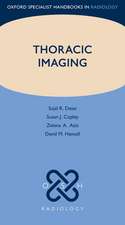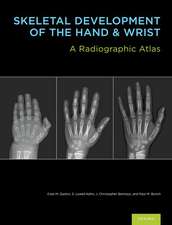Deformable Models: Biomedical and Clinical Applications: Topics in Biomedical Engineering. International Book Series
Editat de Aly Faragen Limba Engleză Paperback – 21 sep 2014
Deformable Models: Biomedical and Clinical Applications will focus on the core mage processing techniques for biomedical and clinical applications.
| Toate formatele și edițiile | Preț | Express |
|---|---|---|
| Paperback (2) | 1424.89 lei 6-8 săpt. | |
| Springer – 21 sep 2014 | 1424.89 lei 6-8 săpt. | |
| Springer – 20 noi 2014 | 1426.33 lei 6-8 săpt. | |
| Hardback (1) | 1470.96 lei 6-8 săpt. | |
| Springer – 2 aug 2007 | 1470.96 lei 6-8 săpt. | |
| Mixed media product (1) | 1432.90 lei 6-8 săpt. | |
| Springer – 2 aug 2007 | 1432.90 lei 6-8 săpt. |
Preț: 1424.89 lei
Preț vechi: 1499.88 lei
-5% Nou
Puncte Express: 2137
Preț estimativ în valută:
272.68€ • 282.96$ • 227.92£
272.68€ • 282.96$ • 227.92£
Carte tipărită la comandă
Livrare economică 17-31 martie
Preluare comenzi: 021 569.72.76
Specificații
ISBN-13: 9781489997067
ISBN-10: 1489997067
Pagini: 576
Ilustrații: XVII, 556 p.
Dimensiuni: 155 x 235 x 30 mm
Greutate: 0.79 kg
Ediția:2007
Editura: Springer
Colecția Springer
Seria Topics in Biomedical Engineering. International Book Series
Locul publicării:New York, NY, United States
ISBN-10: 1489997067
Pagini: 576
Ilustrații: XVII, 556 p.
Dimensiuni: 155 x 235 x 30 mm
Greutate: 0.79 kg
Ediția:2007
Editura: Springer
Colecția Springer
Seria Topics in Biomedical Engineering. International Book Series
Locul publicării:New York, NY, United States
Public țintă
ResearchCuprins
Simulating Bacterial Biofilms.- Distance Transform Algorithms And Their Implementation And Evaluation.- Level Set Techniques For Structural Inversion In Medical Imaging.- Shape And Texture-Based Deformable Models For Facial Image Analysis.- Detection Of The Breast Contour In Mammograms By Using Active Contour Models.- Statistical deformable models for cardiac Segmentation and Functional Analysis In Gated-Spect Studies.- Level Set Formulation For Dual Snake Models.- Accurate Tracking Of Monotonically Advancing Fronts.- Toward Consistently Behaving Deformable Models For Improved Automation In Image Segmentation.- Application Of Deformable Models For The Detection Of Acute Renal Rejection.- Physically And Statistically Based Deformable Models For Medical Image Analysis.- Deformable Organisms For Medical Image Analysis.- Pde-Based Three Dimensional Path Planning For Virtual Endoscopy.- Object Tracking In Image Sequence Combining Hausdorff Distance, Non-Extensive Entropy In Level Set Formulation.- Deformable Model-Based Image Registration.
Notă biografică
Aly A. Farag received the bachelor degree from Cairo University, Egypt and the PhD degree from Purdue University in Electrical Engineering. He also holds master degrees in bioengineering from the Ohio State and the University of Michigan. He is a University Scholar and Professor of Electrical & Computer Engineering at the University of Louisville. Dr. Farag is the founder and director of the Computer Vision and Image Processing Laboratory (CVIP Lab) which focuses on imaging science, computer vision and biomedical imaging. Dr. Farag main research focus is 3D object reconstruction from multimodality imaging, and applications of statistical and variational methods for object segmentation and registration. He has authored over 250 technical papers in the field of image understanding and holds a number patents. He is regular reviewer to a number of professional organizations in the United States and abroad, and a member of the editorial boards of a number journals and international meetings.
Jasjit S. Suri, PhD is an innovator, scientist, a visionary, and industrialist and an internationally known world leader in Biomedical Engineering and Biological Sciences. Dr. Suri has spent over 20 years in the field of biomedical engineering, devices and its management. He received his Doctorate from the University of Washinton, Seattle and Master's in Executive Business Management from Weatherhead, Case Western Reserve University, Cleveland, Ohio. Dr. Suri was crowned with the President's Gold Medal in 1980 and elected as a Fellow of the American Institute for Medical and Biological Engineering.
Jasjit S. Suri, PhD is an innovator, scientist, a visionary, and industrialist and an internationally known world leader in Biomedical Engineering and Biological Sciences. Dr. Suri has spent over 20 years in the field of biomedical engineering, devices and its management. He received his Doctorate from the University of Washinton, Seattle and Master's in Executive Business Management from Weatherhead, Case Western Reserve University, Cleveland, Ohio. Dr. Suri was crowned with the President's Gold Medal in 1980 and elected as a Fellow of the American Institute for Medical and Biological Engineering.
Textul de pe ultima copertă
Deformable Models: Biomedical and Clinical Applications is the first entry in the two-volume set which provides a wide cross-section of the methods and algorithms of variational and Partial-Differential Equations (PDE) methods in biomedical image analysis. The chapters of Deformable Models: Biomedical and Clinical Applications are written by the well-known researchers in this field, and the presentation style goes beyond an intricate abstraction of the theory into real application of the methods and description of the algorithms that were implemented. As such these chapters will serve the main goal of the editors of these two volumes in bringing down to earth the latest in variational and PDE methods in modeling of soft tissues.
Overall, the chapters in the first volume provide an elegant cross-section of the theory and application of variational and PDE approaches in medical image analysis. This volume introduces, discusses, and provides solutions for problems ranging from structural inversion to models for cardiac segmentation, and other applications in medical image analysis. Graduate students and researchers at various levels of familiarity with these techniques will find the volume very useful for understanding the theory and algorithmic implementations. In addition, the various case studies provided demonstrate the power of these techniques in clinical applications.
Researchers at various levels will find these chapters useful to understand the theory, algorithms, and implementation of many of these approaches.
Overall, the chapters in the first volume provide an elegant cross-section of the theory and application of variational and PDE approaches in medical image analysis. This volume introduces, discusses, and provides solutions for problems ranging from structural inversion to models for cardiac segmentation, and other applications in medical image analysis. Graduate students and researchers at various levels of familiarity with these techniques will find the volume very useful for understanding the theory and algorithmic implementations. In addition, the various case studies provided demonstrate the power of these techniques in clinical applications.
Researchers at various levels will find these chapters useful to understand the theory, algorithms, and implementation of many of these approaches.
Caracteristici
Covers the complete spectrum of deformable models - its evolution as an imagery field and its use in many biomedical engineering and clinical application disciplines Includes level sets, PDEs, curve and surface evolution and their applications in biomedical fields covering both static and motion imagery Includes supplementary material: sn.pub/extras













